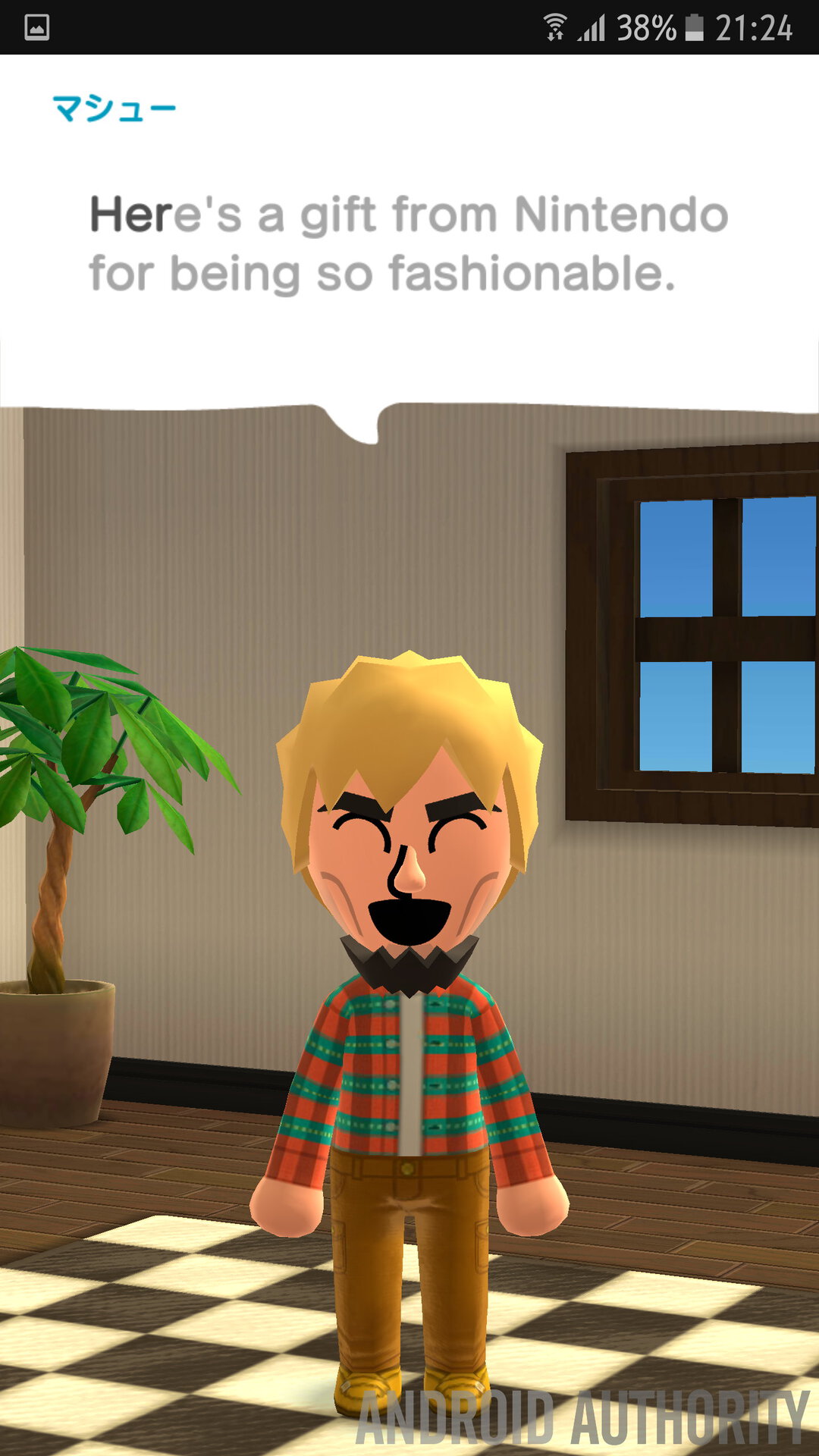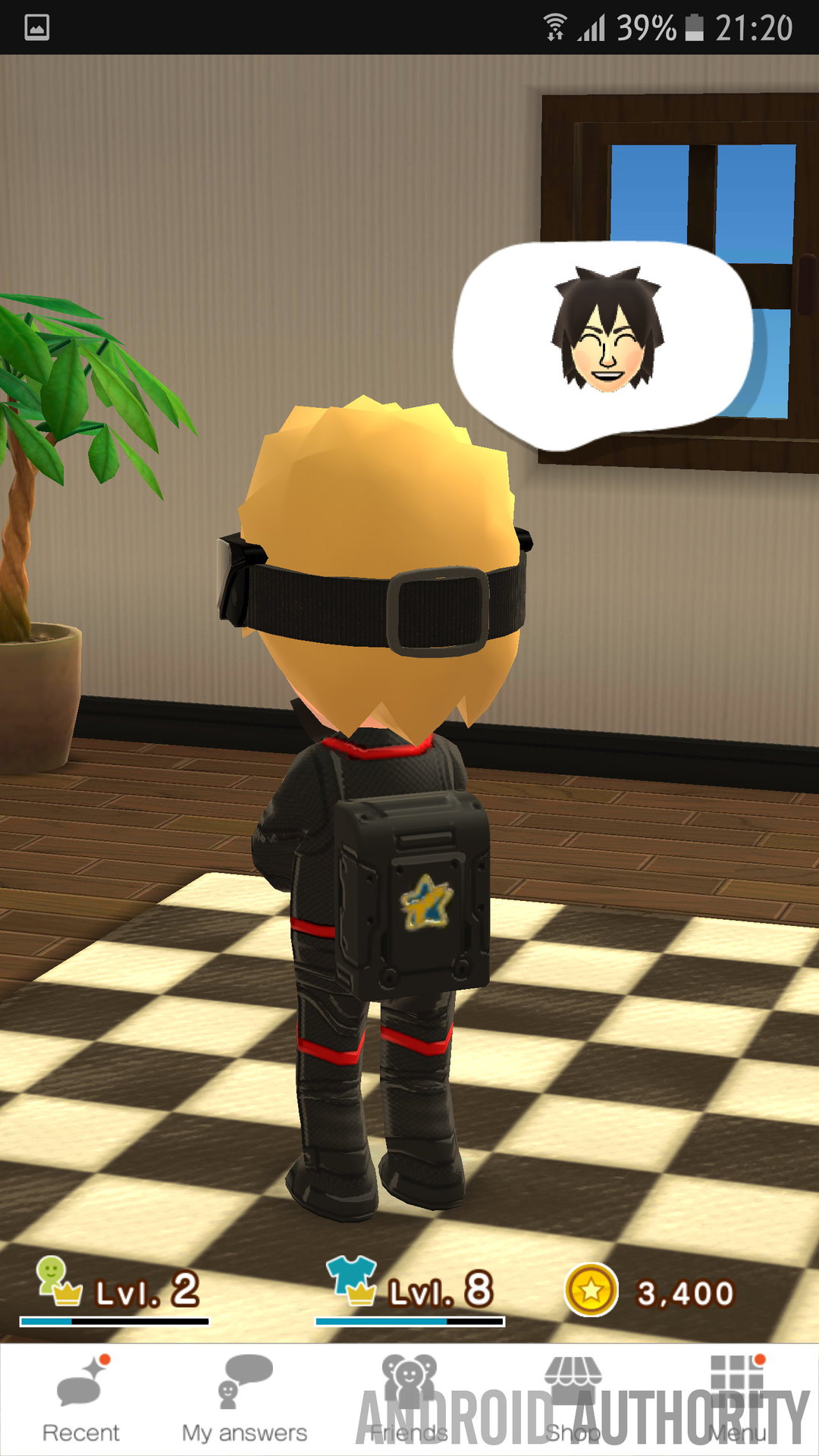Affiliate links on Android Authority may earn us a commission. Learn more.
Miitomo impressions: Nintendo's fledgling first app is a curious creation

When Nintendo announced it was planning to make mobile games last year, the first thoughts fans probably involved the Mario Bros., Link and Zelda, or perhaps even Pokemon. While no specific product was announced, a partnership was: one of Japan’s most venerable and historic gaming companies was partnering with, DeNA, a company born out of the smartphone era that openly embraces the freemium business model. Nintendo, sensing the apprehension, issued a statement that sought to reassure those concerned that the partnership would not realize those fears.
Fast forward to the announcement of the first fruit of the foray: Miitomo, a game that was finally released last month and which quickly netted a million downloads after just three days. This post will aim to “review” Miitomo, in as much as a non-game can be reviewed. It will begin with a brief introduction to the “Mii” idea itself, and then explore what the app has to offer, what it lacks, and why someone might be interested in testing it out.
Mii no understand
In order to “get” the concept behind Miitomo, one must first understand what a Mii is. The concept was given life almost a decade ago when Nintendo launched the original Wii. As the home console was aimed at casual gamers and families, the decision was made to allow users to create digital avatars. This, in turn, would allow each person in the family to control a “unique” player in more generic games like Nintendo Sports. The concept was then brought to the Nintendo 3DS and most recently, the Wii U.
Around the same time as the Wii was an active SKU, Nintendo released the Japan-exclusive “Tomodachi Collection” for the Nintendo DS. While not a traditional game per se, the title saw users creating (or importing) a Mii, after which they could add friends via the avatar creation engine or by exchanging them with others. Users could maintain an apartment building of the characters where it was possible to visit the other characters. The game also included shops and locals that allowed for changing clothing and buying presents.
A sequel was made for the 3DS, released in North America as Tomodachi Life. In fact, much like how Pokemon was first “introduced” to America, what arguably put Tomodachi Collection on the map for many mainstream ‘Mericans was a specific controversy involving a belief that the game was discriminatory towards same-sex lifestyles.
Miitomo is, at its core, a more social-oriented, bare-bones spin-off of Tomodachi Life.
What’s it about
As of this moment, Nintendo’s first foray into the mobile space is rather confined. Users begin by creating a Mii, or importing one from their Nintendo consoles. This includes not only customizing the character’s face, but also their personality and even speaking style. The game then assigns a personality type to the final creation. The picture gallery immediately above provides a glimpse at the process.
After this point, there is a limited amount of interaction possible. The user’s Mii will walk around a virtual apartment room. At points throughout the day, it will ask personal information questions, such as “What do you love the most?” or “What did you do last weekend?”. The answers are then saved for perusal later.

The money-making-magic deals with clothing. The game has an expansive array of clothing and accessories to dress your mini Mii in, and while the app does provide in-game currency from answering questions and occasionally other tasks, real-world money is needed for any balance insufficiency. There is also a ball drop mini-game element which requires game tickets to play with the prizes being, of course, rare clothing. These tickets are also occasionally earned in-game, but are basically pay-to-play.
Here is a look at the fashion aspect. The picture on the left is the clothing store where real world money can be spent to buy new fashion and the right is basically a running list of advertisements for themed ball-drop mini-games where exclusive fashion can be won:
Here is a look at the Mii Closet where users can change their clothing:
Change clothing enough and your style level will increase along with a bonus from Nintendo in the form of a free mini-game ticket:

More fun with friends
At its core, Miitomo is meant to be a virtual social networking app and therefore it’s meant to be experienced with friends. To do this, the game asks to link with Facebook and Twitter. It will then search to see if any friends are using the app as well and suggest adding them. Alternatively, it’s also possible to add someone with a face-to-face connection (i.e. in real life). After they will begin to visit your Mii and you will have to answer their questions, too.

Quite frankly, it borders on stalking/obsession, especially when one’s friends list is limited to just a few people. The user’s Mii will constantly be thinking about the friend’s Mii and, as the app is not a full-fledged game, all there is to do is reply to their questions and responses. Yet because it’s not an actual social network, it’s not actually possible to post status updates or leave general commentary. Much like how with Jeaporody! every answer must be worded as a question, with Miitomo, the only response can come from one.
Confounding connectivity (or lack thereof)
The fact that, from the outset, Miitomo has allowed for users to link to their Facebook and Twitter accounts is a great idea, and a fantastic way – in theory – to rapidly expand the potential installed user base. Once you link your accounts, anyone on your Friends or Followers lists will be automatically suggested as Mii social mates within the app. Additionally as mentioned earlier, a face-to-face type manner of adding friends in real life can also be initiated.
Outside of this connectivity, there is effectively no way to add friends in the most logical way one might think possible: by sending your friends your Mii. While the app technically does allow users to send their Mii to others, this is for a downright confusing purpose: apparently it’s designed to let your friends edit your Mii, though this “Other Mii” is not counted as a friend. Even more paradoxical is the fact that, with a version update, it’s now possible to add your friend’s friend’s Mii to your list.
Nintendo really needs to wake up an realize that there are people who don’t use Twitter or Facebook in the world (or who don’t want their friends and followers knowing they use Miitomo) and allow users to add friend’s Mii via QR code sent from SMS or e-mail.
Safe for kids (except when it’s not)
For the mainstream smartphone user, Miitomo will likely have no appeal whatsoever. The cutsey – though charming in their own way – characterizations will likely serve to turn off more people than appeal. This is not unlike why many Westerners have made disparaging comments about Japan’s popular Line messaging app due to its heavy reliance on overly cute stickers as a prime way of communication. Take a look at the kind of cute-content that can be expected:
If one had to wager a guess, Miitomo will probably be best received by kids under the age of 13 – probably more so females than males due to the large focus on style and fashion. After just a few minutes with the product, the clean, cartoonish creation will no doubt scream “kid friendly” though rest assured adults may also find the app to be a lot of fun.
Perhaps the problem with the kid connection is that Nintendo has not sought to include any censorship filters within the game. This means that anyone can post explicit commentary, including sexually suggestive words, in the responses given to their Mii’s, and their friends. Because there is currently no filter, any comment posted – save for those marked “Just Between Us” – is viewable by anyone on the friend list.
It’s only a matter of time before someone’s dirty uncle makes a perverted comment to their same-age friends and little Jack or Jane asks their parent what such a phrase means. Nintendo – a kid-friendly, family focused company – will likely take a lot of heat should situations such as this hit the media.
Wrap up
Miitomo is a curious creation from Nintendo that is sure to appeal to a set group of people, instantly put off another, and exist off the radar entirely for everyone else. Nintendo may well have a hit on its hands, but points have been raised that if the company can’t get over X million downloads, it will be difficult to say it has even managed to expand the app’s appeal beyond its existing fanbase. Then again, perhaps it doesn’t matter as many millions of installations is still something.
The question, though, is will Miitomo provide the IAP-cash that Nintendo so clearly hopes to pocket. Buying new clothing is a fun way to constantly change the Mii’s look, but just how many people will be interested in paying cold hard cash for a virtual outfit? The issue is all the more questionable when considering that the user earns in-game currency just for answering questions, and thus it’s possible to “save up” for any given purchase.
If the screen captures are appealing, and/or if one is a Nintendo fan, then giving Miitomo a chance is definitely a fun way to spend a few minutes playing around with. Now, as for if that appeal lasts for more than a few minutes…that’s another question entirely.